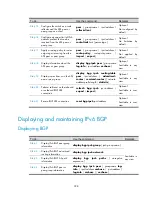
398
To do…
Use the command…
Remarks
Step 15
Configure the switch as a route
reflector and the 6PE peer or
peer group as a client
peer
{
group-name
|
ipv4-address
}
reflect-client
Optional
Not configured by
default
Step 16
Configure an upper limit of IPv6
address prefixes that can be
received from the 6PE peer or
peer group
peer
{
group-name
|
ipv4-address
}
route-limit
limit
[
percentage
]
Optional
No limitation by
default
Step 17
Apply a routing policy to routes
outgoing or incoming from the
6PE peer or peer group
peer
{
group-name
|
ipv4-address
}
route-policy
route-policy-name
{
import
|
export
}
Optional
Not applied by
default
Step 18
Display information about the
6PE peer or peer group
display bgp ipv6 peer
[
group-name
log-info
|
ipv4-address
verbose
]
Optional
Available in any
view
Step 19
Display routes from or to the 6PE
peer or peer group
display bgp ipv6 routing-table
peer
ipv4-address
{
advertised-
routes
|
received-routes
} [
network-
address prefix-length
|
statistic
]
Optional
Available in any
view
Step 20
Perform soft reset on the inbound
or outbound BGP 6PE
connection
refresh
bgp
ipv6
ipv4-address
{
export
|
import
}
Optional
Available in user
view
Step 21
Reset a BGP 6PE connection
reset bgp ipv6
ipv4-address
Optional
Available in user
view
Displaying and maintaining IPv6 BGP
Displaying BGP
To do…
Use the command…
Remarks
Step 1
Display IPv6 BGP peer group
information
display bgp ipv6
group
[
ipv6-group-name
]
Available in
any view
Step 2
Display IPv6 BGP advertised
routing information
display bgp ipv6 network
Step 3
Display IPv6 BGP AS path
information
display bgp ipv6
paths
[
as-regular-
expression
]
Step 4
Display IPv6 BGP peer or
peer group information
display bgp ipv6 peer
[
group-name
log-
info
|
ipv4-address
verbose
|
ipv6-address
{
log-info
|
verbose
} |
verbose
]
















































